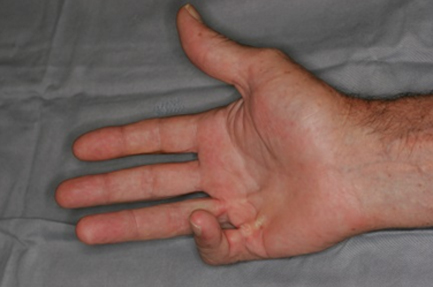Dupuytren’s Contracture Causes, Symptoms, Diagnosis and Treatment

What Is Dupuytren’s Contracture?
Dupuytren’s contracture is a flexion contracture or deformity of the hand which usually develops over years.
It is marked by bending of the fingers towards the palm and does not allow the palm to be fully extended. It is an inherited proliferative connective tissue disorder that involves the hand’s palmar fascia.
The ring and little finger are the fingers most commonly affected. Dupuytren’s contracture progresses slowly and is often accompanied by some aching and itching. In patients with this condition, the palmar fascia thickens and shortens so that the tendons connected to the fingers cannot move freely.
Acquisition of dupuytren’s contracture increases after the age of 40, and affect males more than females. There are treatments available which serve to slow the progression of Dupuytren’s contracture and relieve symptoms.
Causes Of Dupuytren’s Contracture:
The underlying cause of dupuytren’s contracture is unknown. However, suspected causes may include trauma, diabetes, epilepsy, and therapy with phenytoin.
If an individual has the gene that causes Dupuytren’s contracture, other factors such as diabetes, smoking and certain medications may activate the condition
Although it has no specific affliction, it generally affects:
- People of Scandinavian or Northern European ancestry
- Men rather than women (men are ten times as likely to develop the condition)
- People over the age of 40
- People with a family history
- Rock climbers
- Alcoholics
Symptoms Of Dupuytren’s Contracture:
Dupuytren’s contracture progresses steadily over the years.
Symptoms include:
- the palmar fascia within the hand becomes abnormally thick,
- Fingers curl
- Impairment of finger function
- Pain
- Itching
- Initial stages involve development of nodules in the palms
- Affected fingers include the ring finger and little finger of one or both hands
Diagnosis Of Dupuytren’s Contracture:
Diagnosis of dupuytren’s contracture can be made via:
- Table top test, which may come positive
The patient places his hand on a table. If the hand lies completely flat on the table, the test is considered negative.
If the hand cannot be placed completely flat on the table, leaving a space between the table and a part of the hand as big as the diameter of a ballpoint pen, the test is considered positive - Physical exam of the hand
Treatment Of Dupuytren’s Contracture:
The following treatment options are available:
- Needling
- Enzyme injections
- Surgery
By : Natural Health News




